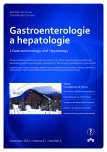Hepatocellular carcinoma – our experience with surveillance, effect and complications of transarterial chemoembolization
Authors:
K. Kubíčková 1
; P. Urbánek 1; I. Buřič 2; H. Parobkova 2; M. Ryska 3; F. Bělina 3; J. Pudil 3; P. Tesařová 4; M. Kupec 5; L. Vítek 6; M. Zavoral 1
Authors‘ workplace:
Interní klinika 1. LF UK a ÚVN, Praha
1
Published in:
Gastroent Hepatol 2013; 67(6): 498-503
Category:
Hepatology: Original Article
Overview
Hepatocellular carcinoma (HCC) is the most common primary liver carcinoma. This type of tumour typically occurs along with chronic liver diseases and thus the population in risk is clearly defined. Due to the more common incidence of HCC the patients with liver conditions should be monitored by specialised outpatient clinics. The recommended HCC surveillance system concerns regular check-ups every six months with an abdomen ultrasound examination. Our experience shows that more than half of patients with liver conditions are not monitored by specialised outpatient clinics and only a third of patients undergo the recommended HCC surveillance system. The vast majority of HCC is diagnosed in the advanced stages allowing only palliative or symptomatic therapy. Transarterial chemoembolization is a very efficient and relatively safe method of palliative therapy in hepatocellular carcinoma, which significantly prolongs the survival rate. The risk of complications depends on the functional condition of liver parenchyma and the size of liver focus. Our set of patients has achieved the mean survival period of 22 months from diagnosis.
Key words:
hepatocellular carcinoma – virus hepatitis B – virus hepatitis C – transarterial chemoembolization
The authors declare they have no potential conflicts of interest concerning drugs, products, or services used in the study.
The Editorial Board declares that the manuscript met the ICMJE „uniform requirements“ for biomedical papers.
Submitted:
30. 9. 2013
Accepted:
11. 11. 2013
Sources
1. Zhang BH, Yang BH, Tang ZY. Randomized controlled trial of screening for hepatocellular carcinoma. J Cancer Res Clin Oncol 2004; 130(7): 417–422.
2. Bruix J, Sherman M. Management of hepatocellular carcinoma. Hepatology 2005; 42(5): 1208–1236.
3. Caldwell SH, Crespo DM, Kang HS et al. Obesity and hepatocellular carcinoma. Gastroenterology 2004; 127 (5 Suppl 1): S97–S103.
4. Brůha R, Šperl J, Urbánek P et al. Doporučený postup pro léčbu a diagnostiku hepatocelulárního karcinomu. Gastroent Hepatol 2012; 66(2): 83–92.
5. Bruix J, Sherman M, American Association for the Study of Liver Diseases. Management of hepatocellular carcinoma: an update. Hepatology 2011; 53(3): 1020–1022.
6. Albrecht T, Blomley MJ, Burns PN et al. Improved detection of hepatic metastases with pulse-inversion Us during the liver-specific phase of SHU 508A: multicenter study. Radiology 2003; 227(2): 361–370.
7. Del Frate C, Zuiani C, Londero V et al. Comparing Levovist-enhanced pulse inversion harmonic imaging and ferumoxides-enhanced MR imaging of hepatic metastases. Am J Roentgenol 2003; 180(5): 1339–1346.
8. Singal A, Volk ML, Waljee A et al. Meta-analysis: surveillance with ultrasound for early-stage hepatocellular carcinoma in patients with cirrhosis. Aliment Pharmacol Ther 2009; 30(1): 37–47.
9. AASLD practice guideline. Available from: http://www.aasld.org/practiceguidelines/Documents/Bookmarked%20Practice%20Guidelines/HCCUpdate2010.pdf.
10. Sheu JC, Sung JL, Chen DS et al. Growth rate of asymptomatic hepatocellular carcinoma and its clinical implications. Gastroenterology 1985; 89(2): 259–266.
11. Makuuchi M, Kokudo N, Arii S et al. Development of evidence-based clinical guidelines for the diagnosis and treatment of hepatocellular carcinoma in Japan. Hepatol Res 2008; 38(1): 37–51.
12. Trinchet JC, Chaffaut C, Bourcier V et al. Ultrasonographic surveillance of hepatocellular carcinoma in cirrhosis: a randomized trial comparing 3 - and 6-month periodicities. Hepatology 2011; 54(6): 1987–1997.
13. European Association for the Study of the Liver, European Organisation for Research and Treatment of Cancer. EASL–EORTC clinical practice guidelines: management of hepatocellular carcinoma. J Hepatol 2012; 56(4): 908–943.
14. Llovet JM, Di Bisceglie AM, Bruix J et al. Design and endpoints of clinical trials in hepatocellular carcinoma. J Natl Cancer Instit 2008; 100(10): 698–711.
15. Llovet JM, Llovet JM, Bruix J. Systematic review of randomized trials for unresectable hepatocellular carcinoma: chemoembolization improves survival. Hepatology 2003; 37(2): 429–442.
16. Burrel M, Reig M, Forner A et al. Survival of patients with hepatocellular carcinoma treated by transarterial chemoembolisation (TACE) using Drug Eluting Beads. Implications for clinical practice and trial design. J Hepatol 2012; 56(6): 1330–1335.
17. Yoon DY, Park JH, Chung JW et al. Iatrogenic dissection of the celiac artery and its branches during transcatheter arterial embolization for hepatocellular carcinoma: outcome in 40 patients. Cardiovasc Intervent Radiol 1995; 18(1): 16–19.
18. Chung JW, Park JH, Im JG et al. Pulmonary oil embolism after transcatheter oily chemoembolization of hepatocellular carcinoma. Radiology 1993; 187(3): 689–693.
19. Clark TW. Complications of hepatic chemoembolization. Semin Intervent Radiol 2006; 23(2): 119–125.
20. Song SY, Chung JW, Han JK et al. Liver abscess after transcatheter oily chemoembolization for hepatic tumors: incidence, predisposing factors, and clinical outcome. J Vasc Interv Radiol 2001; 12(3): 313–320.
Labels
Paediatric gastroenterology Gastroenterology and hepatology SurgeryArticle was published in
Gastroenterology and Hepatology

2013 Issue 6
- Metamizole vs. Tramadol in Postoperative Analgesia
- The Importance of Limosilactobacillus reuteri in Administration to Diabetics with Gingivitis
- Safety and Tolerance of Metamizole in Postoperative Analgesia in Children
- Metamizole in perioperative treatment in children under 14 years – results of a questionnaire survey from practice
Most read in this issue
- Diagnosis of disorders of gastric emptying in diabetic patients with diabetic autonomic neuropathy
- Endoscopic resolution of refractory postoperative bile leak from bile duct with fully covered self-expandable metallic stent
- Guidelines of the Czech gastroenterological society – endoscopic treatment of Barrett´s esophagus and early esophageal neoplasia
- Hepatocellular carcinoma – our experience with surveillance, effect and complications of transarterial chemoembolization
